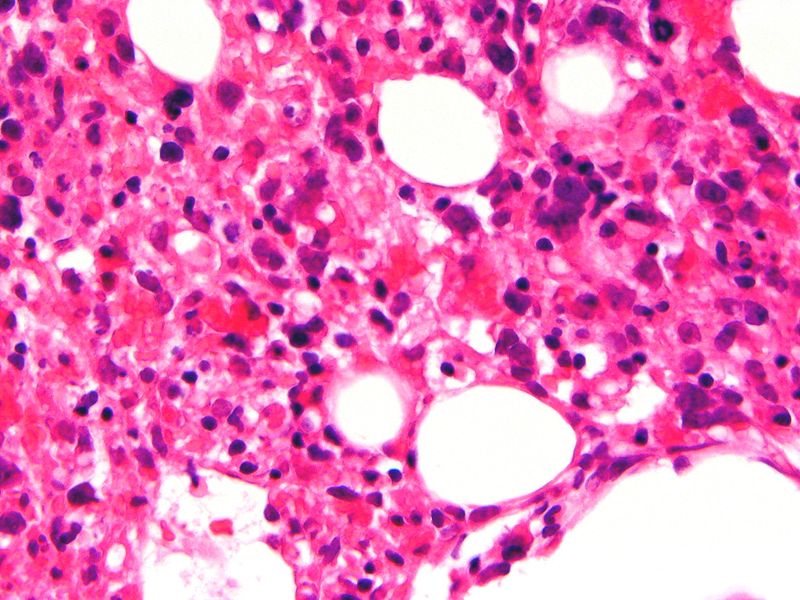Hemophagocytic lymphohistiocytosis: Difference between revisions
No edit summary |
m (Robot: Changing Category:Disease state to Category:Disease) |
||
| Line 58: | Line 58: | ||
{{Hematology}} | {{Hematology}} | ||
{{SIB}} | {{SIB}} | ||
[[pl:Histiocytoza X]] | |||
{{WikiDoc Help Menu}} | |||
{{WikiDoc Sources}} | |||
[[Category:Disease | [[Category:Disease]] | ||
[[Category:Pediatrics]] | [[Category:Pediatrics]] | ||
[[Category:Hematology]] | [[Category:Hematology]] | ||
| Line 66: | Line 71: | ||
[[Category:Autosomal recessive disorders]] | [[Category:Autosomal recessive disorders]] | ||
[[Category:Mature chapter]] | [[Category:Mature chapter]] | ||
Revision as of 20:28, 9 December 2011
| Hemophagocytic lymphohistiocytosis | |
 | |
|---|---|
| Light microscopic image of bone marrow showing stromal macrophages containing numerous red blood cells in their cytoplasm | |
| ICD-10 | D76.1 |
| ICD-9 | 288.4 |
| OMIM | 267700 603552 |
| DiseasesDB | 31418 |
| MeSH | D051359 |
Editor-In-Chief: C. Michael Gibson, M.S., M.D. [1]
Please Take Over This Page and Apply to be Editor-In-Chief for this topic: There can be one or more than one Editor-In-Chief. You may also apply to be an Associate Editor-In-Chief of one of the subtopics below. Please mail us [2] to indicate your interest in serving either as an Editor-In-Chief of the entire topic or as an Associate Editor-In-Chief for a subtopic. Please be sure to attach your CV and or biographical sketch.
Overview
Hemophagocytic lymphohistiocytosis (HLH) is an unusual syndrome characterized by fever, splenomegaly, jaundice, and the pathologic finding of hemophagocytosis. This is phagocytosis by macrophages of erythrocytes, leukocytes, platelets, and their precursors in bone marrow and other tissues.
HLH may be associated with malignant, genetic, or autoimmune diseases. It is also prominently linked with Epstein-Barr virus (EBV) infection, however it can also be associated with other viruses as well as fungal infections.
Hyperproduction of cytokines, including interferon-g and tumor necrosis factor-a, by EBV-infected T lymphocytes may play a role in the pathogenesis of HLH. EBV-associated HLH may mimic T-cell lymphoma and is treated with cytotoxic chemotherapy. In contrast, hemophagocytic syndromes associated with nonviral pathogens often respond to treatment of the underlying infection.
HLH comprises familial (primary) hemophagocytic lymphohistiocytosis (FHL) and secondary HLH (SHLH), both clinically characterized by the features described above, in particular fever, hepatosplenomegaly, and cytopenia.
Familial forms
FHL, an autosomal recessive disorder, is invariably fatal when untreated. It is associated with defective triggering of apoptosis and reduced cytotoxic activity, resulting in a widespread accumulation of T lymphocytes and activated macrophages.
There are four types, and each is associated with a specific gene:

References
- Fisman DN (2000). "Hemophagocytic syndromes and infection". Emerging Infect. Dis. 6 (6): 601–608. PMID 11076718.
- Henter JI, Samuelsson-Horne A, Aricò M; et al. (2002). "Treatment of hemophagocytic lymphohistiocytosis with HLH-94 immunochemotherapy and bone marrow transplantation". Blood. 100 (7): 2367–2373. doi:10.1182/blood-2002-01-0172. PMID 12239144.
External links
- http://www.hrtrust.org/library/HLHSymptomsSignsAndDiagnosis.html
- Histiocytosis at eMedicine
- http://www.histio.org
- http://www.jonahchuang.com
- http://www.elyseyu.com
- http://www.ethanmichaelsmith.com
- http://www.savejonah.com
Template:Hematology Template:SIB